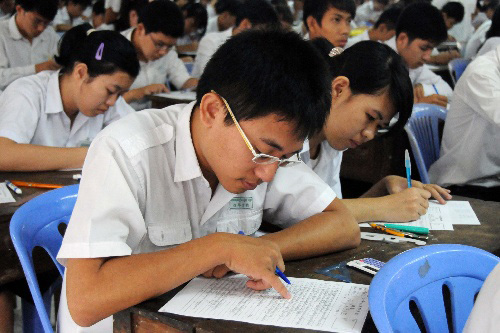Cambodians in Search of Brighter Future Hit Books at Large Chinese School

(Phnom Penh, Cambodia) – Seventeen-year-old Cambodian student Tep Raska wants to trade glassware with Chinese businessmen after he graduates, but he struggles for a moment to find the right Mandarin word for "trade". Instead, searching for the pronunciation of each word, he says: "I want to buy and sell glassware."
The boy started learning Mandarin two years ago. Like Tep Raska, an increasing number of Cambodians have chosen to attend Duanhua, a school that caters to descendants of Chinese and teaches classes in Mandarin. The school has two campuses in the capital, Phnom Penh, and 16,000 students aged 5 to 17 years old in more than 100 classes.
About 5 percent of the students are Cambodians, a teacher at the school said. Ten years ago the figure was between 2 and 3 percent.
Car, motorcycles and tuk-tuk tricycles whir through the small lanes around the school, and a strong sun illuminates the dust rising off the street. A group of children buy snacks and stationary by the road lined with trash giving off an unpleasant odor. When the school's bell rings, students flood back into the teaching hall and their desks.
Duanhua is the largest Chinese school in Southeast Asia. It was founded 1915 by an association of Chinese businessmen from the southern province of Guangdong and was Cambodia's top school in the 1950s and 19060s. Like all other Chinese schools, it was closed by the government of the Khmer Republic (1970-1975), and did not reopen until 1992.
It has grown fast over the past decade, benefitting from donations from alumni and China's embassy in Cambodia. In 1995, it opened the second campus, which got a new teaching building seven years later. Late last year it built another building on the campus with funds donated by alumni and the embassy. The number of students has risen over the past two years by 700.
Principal Li Huiming said China's growing strength and influence explained the school's development. Learning Chinese "makes it easier to find a job, especially those in relatively high-end sectors, such as engineering and banking," he said. "Many investors are Chinese. Whether they are from the mainland, Hong Kong, Taiwan or Malaysia, they all speak Chinese."
A Most Trusted Friend
Cambodia has a population of 15 million, and an estimated 1 to 5 percent of the people have Chinese ancestry. That group wields strong economic and political influence.
China is now Cambodia's largest foreign investor. From 1994 to September 2011, 20 percent of the US$ 40 billion worth of projects approved by the Cambodian government came from China, according to the Council for the Development of Cambodia, the country's highest decision-making body for private and public sector investment.
Most of the Chinese investments went into areas like natural resources, energy, large-scale infrastructure construction, agricultural development and tourism.
China is also an important trade partner and a major aid donor. Bilateral trade has risen dramatically, especially after Cambodia became a full member of the Association of Southeast Asian Nations (ASEAN) in 1999. China has also lent generously to Cambodia, financing part of the US$ 49 million Council of Ministers building in Phnom Penh. The country's cabinet moved into the facility in 2010.
Cambodia and China often agree on diplomatic matters. In 2012, the ASEAN ministers' meeting in Phnom Penh failed to produce a joint communiqué for the first time in the organization's 45-year history. Observers said this was mainly due to Cambodia's objection to including in the document discussions about sea disputes that the Philippines and Vietnam have with China.
Cambodia is likely to continue to have good rapport with China, several experts on international relations in Phnom Penh said. Cambodian Prime Minister Hun Sen, who has led the nation for 16 years, has repeatedly called China his country's "most trusted friend." Cambodia also needs China on its side when dealing with Vietnam, the experts say.
Staff reporter Zhou Tian contributed to this article
(Rewritten by Patrick Williams)
- MOST POPULAR







